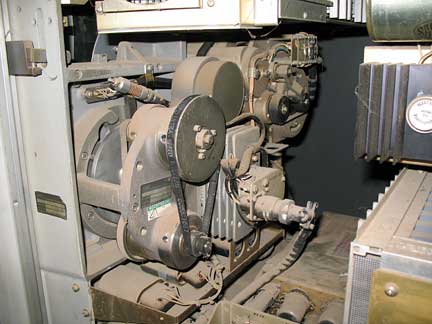
After 20 years, the White House ban on images of American war dead ended last night. Ralph Begleiter, who fought to lift it, wonders if the photos will change hearts and minds. VIEW OUR GALLERY
Six years into the war in Iraq—and after nearly eight years of combat in Afghanistan—the U.S. government last night resumed allowing news photographers to take pictures and video of American casualties returning home, in flag-draped caskets, at Dover Air Force Base in Delaware. The remains of 30-year-old Staff Sgt. Phillip Myers of Hopewell, Va., who was killed in Afghanistan, landed at Dover after dark Sunday night, just before the new media-coverage policy was scheduled to take effect. The Defense Department notified news organizations a few hours earlier that the deceased airman’s family had authorized media coverage. It was a bright moonlit night in Delaware as the flag-draped casket of Sgt. Myers was carried across the tarmac to the military mortuary at Dover. A small number of news photographers were on hand to record the event, which marked the reversal of a policy set in 1989 by then-president George H.W. Bush, who was embarrassed by pictures of dead American soldiers from Dover. There were no “live” pictures permitted at Dover last night under the new Pentagon policy; it was “live” coverage from Dover that triggered the media ban two decades ago.
Click Image Below to View Our Gallery

The Pentagon itself had continued to take pictures of the returning casualties until 2005, at the height of the Iraq war. They remain some of the most respectful images imaginable, of Honor Guards in dress uniform and aircraft crews escorting their fallen comrades home. They document the honorable way our government brings U.S. troops home from combat. The military had been documenting the return of casualties for several decades, even when the news media showed no interest.
But in 2005, when Defense Department lawyers realized they couldn’t keep those government images from becoming public, the military ordered an end to its own photography. More than 700 photos had been forced into public view by my Freedom of Information lawsuit together with the National Security Archive at George Washington University. To my knowledge, the media ban—combined with the halt to government photography—has forever hidden images the thousands of troops who passed through Dover on their way to burial from mid-2005 until today.
News organizations—especially television—have discovered that Americans don’t want to watch the war in progress. Newscast ratings actually decline when reports from Iraq and Afghanistan appear on television.
The Pentagon’s change in policy at least revives the means for a crucially important documentation of the cost of war. But that doesn’t mean Americans will see those photos.
In the wake of President Bush’s “Mission Accomplished” aircraft carrier speech in 2003, U.S. news organizations—especially television—have discovered that Americans don’t want to watch news of the war. Newscast ratings actually decline when reports from Iraq and Afghanistan appear on television. Major newspapers still spend valiantly to support award-winning combat coverage and other international reporting, but they cringe when they observe readers casually tossing away the main news section, the local and international news sections and the business section before even leaving the newsstand. Most newspapers and broadcasters, including cable news channels, have been sharply trimming international journalism staffs, on-air minutes, or column inches.
As a result, when those hundreds of images of returning casualties became public in 2005 under the Freedom of Information Act, few news organizations published them. In at least one case, a Seattle newspaper’s decision to publish caused the photographer—a contractor for the U.S. military in Iraq—to lose her job for releasing the picture. I was bombarded with some of the basest attacks imaginable for merely seeking to bring the Pentagon’s own respectful photography to light.
After the media ban was ratcheted up in 2003, I was surprised that U.S. news organizations did not protest. When the National Security Archive and I sought release of the government’s own photographs, news organizations did not join in the effort, or seek to lift the media ban.
Why not? In 2001 and 2002, the nation’s post-9/11 “United We Stand” atmosphere discouraged news organizations even from asking tough questions about antiterrorism security issues, much less about an arcane photography ban at the military mortuary at Dover. By 2003, the media were busy suiting up for embedded war coverage in Iraq. During the 2004 election-year antimedia campaigns, news organizations declined to ask their lawyers to fight the ban on photography at Dover. In fact, it remained a surprise when CNN’s Ed Henry prompted President Obama in February to reveal that the media ban was already under review in the new administration. That review was apparently not prompted by media complaints.
Under the Obama administration’s lifting of the ban, families of returning casualties now wield a veto over whether the American people can pay respects to the troops who enlisted, served and died for their nation. I predict many families, like that of Sgt. Myers at Dover Sunday night, will want the return of their loved ones to be publicly honored for their immense sacrifice, rather than swept under a rug.
But after the novelty of photography at Dover wears off, don’t expect U.S. news media to return for pictures of the casualties from Iraq or Afghanistan on a regular basis.
But the new policy brings another important change: The Pentagon itself last night resumed its time-honored tradition of documenting the return of war casualties with compelling pictures taken by its own photographers. Those government images should be part of the public record of war.
Ralph Begleiter was CNN’s world-affairs correspondent from 1981-1999. He teaches journalism and political science at the University of Delaware.














 Get up close and personal, with a high-res look at
Get up close and personal, with a high-res look at 
 If you're a plastic surgery zinger aficionado or
If you're a plastic surgery zinger aficionado or 



















